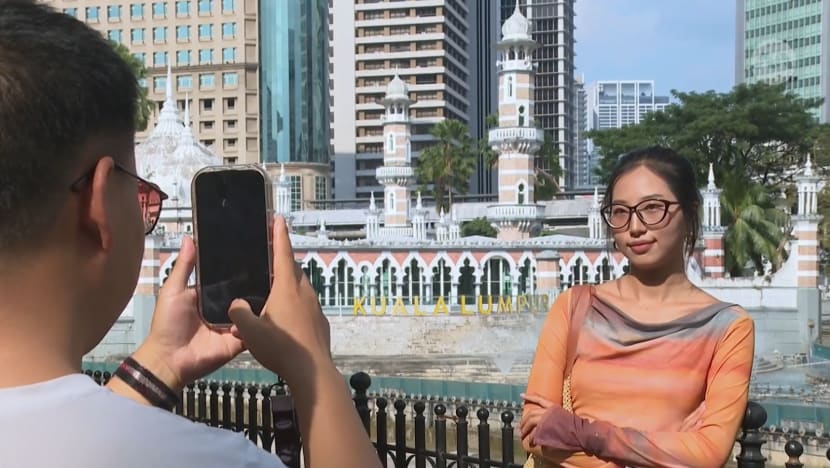Malaysia focuses on attracting young Chinese tourists after missing 2024 target
The Southeast Asian nation aimed to draw 5 million travellers from China to its shores last year.

A tourist posing at the River of Life attraction in Kuala Lumpur.

This audio is generated by an AI tool.
KUALA LUMPUR: Malaysia has turned its focus to attracting young travellers this year in its bid to woo more tourists from mainland China, which remains among the country’s largest sources of foreign tourists.
This comes as the Southeast Asian nation missed its ambitious target in 2024 of drawing 5 million Chinese tourists to its shores.
Still, last year’s numbers were a hefty 160 per cent increase from the previous year’s. As of October, Malaysia welcomed just over 4 million Chinese tourists in 2024, while it drew about 1.4 million of them in the whole of 2023.
As part of efforts to boost its economy and the tourism sector, Malaysia began allowing China citizens to enter visa-free for 30 days from Dec 1 last year until the end of 2026.
The number of direct and charter flights between both countries has also increased, while efforts by states like Melaka to court Chinese tourists have paid off.
As part of its Visit Melaka 2024 campaign, it introduced new attractions and appointed actress Fan Bingbing as the state’s tourism ambassador.
GREATER COLLABORATION NEEDED
Industry experts have called for greater collaboration among tourism players to embrace digitalisation and roll out unique products to attract a growing number of young travellers, known as millennials and Gen Zs.
Many of these tech-savvy youths are looking for new experiences like cultural and sustainable tourism, making traditional travel fairs – which usually cater to large tour groups – a hard sell.
“It’s a global trend … they’re looking for something better. In Beijing, they’re having problems with the pollution and everything, so they come here maybe for lung cleansing,” said Uzaidi Udanis, founder of Your Inbound Matters podcast and tourism community.
“They want experience; they want to have something they can bring back. That's the reason why we have to change our mindset. We no longer expect groups coming in.”
He said the Malaysian government is not spending enough to promote tourism, noting that it is getting expensive to promote on social media and reach the right markets.
According to Uzaidi, tourism contributes about 15 per cent of the country’s gross domestic product and is the biggest employer, hiring about 4 million people.
“The tourism and hospitality business requires a human touch and cannot be replaced by AI, but we can use AI and leverage on data to have more personalised service,” he added.
At a tourism conference held in Kuala Lumpur in October last year, industry players were urged to harness AI to appeal to younger tourists amid rising costs.
They told CNA that creating an emotional connection is key, as well as unique products that focus on diverse cultures and ethnicities, culinary experiences, and environmental conservation.
SUPER APPS, MORE FLIGHTS
Malaysian airline AirAsia is targeting more travellers by creating its own travel super app.
The budget carrier is also planning to add four more destinations to the existing 18 cities it currently flies to in China. It now operates 250 flights weekly there.
AirAsia said traffic has increased by 75 per cent since the 30-day visa-free arrangement was announced in late 2023.
The carrier’s CEO Fareh Mazputra Fairuz said that while costs must always be considered, consumer experience is one of the key factors to success in its eyes.
“We are continuously looking at efforts in fuel conservation, lowering carbon emission and all those things. So definitely, sustainability in aviation is extremely important to us,” he added.
This also comes as Malaysia eyes more arrivals from India, Russia and the Middle East ahead of its Visit Malaysia Year 2026 campaign, which was officially launched by Prime Minister Anwar Ibrahim on Monday (Jan 6). The campaign’s logo was unveiled on the aircrafts of AirAsia, Malaysia Airlines and Batik Air.
The campaign has set an ambitious target of attracting 35.6 million tourists and generating US$33 billion in tourism receipts in 2026.
Meanwhile, experts said seamless online booking and payment systems have greatly facilitated travel between Malaysia and China.
"I think in Asia, to go smart - no cash, we all pay on our mobiles. And China in particular is very advanced in this area and we have very popular super apps like AliPay,” said Sarah Wang, regional director for Asia at the World Travel and Tourism Council – a forum for the travel and tourism industry.
“If I use my AliPay app and I come to Malaysia, it's accepted. I don't need to download another app. And that will really ease my travel,” she added.

















